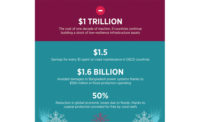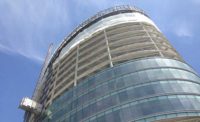At a time when consensus seems rare, Americans are united around the need to repair and modernize our crumbling infrastructure. As policy makers wrestle with the challenge of how to fund this massive undertaking, it is critical taxpayers are able to trust that every dollar invested is well spent.
What if we could turn every dollar invested into $1.20 in spending power? By aggressively adopting advanced technologies that are available today, we can.
Secretary of Transportation Elaine Chao captured the point perfectly in her confirmation hearing when she said, “It’s also important to recognize that the way we build and deliver projects is as important as how much we invest.”
The issue is not just what we spend, but how we spend, that will make the difference.
Here’s how.
Using building information modeling—BIM—will allow state transportation departments, transit agencies, and the federal government to do far more with existing federal taxpayer dollars by building virtually first, to validate the approach and costs. Virtually building a project first slashes risk, waste, and rework that can lead to major cost overruns.
BIM goes beyond just design and construction. BIM also helps improve worker safety and long-term maintenance and operations of critical infrastructure. Efficiency and cost savings are what taxpayers want and should expect in government spending.
Countries and cities around the world are implementing or exploring the implementation of BIM policies, including China, Germany, the United Kingdom, Dubai, France, Australia, and nations across the European Union, to name just a few.
Perhaps we should take a page out of the U.K.’s playbook. The U.K. is seen as a BIM leader that implemented a government-wide BIM policy with a goal of saving 15% to 20% percent on all government-funded projects. As a result, from 2009 through 2015, BIM saved U.K. taxpayers nearly £900 million, or the equivalent of just north of $1 billion U.S. dollars. BIM works.
If we were to pair a $1-trillion infrastructure investment vision with a similar BIM policy—whether this is the vision of President Trump, Senate Democrats, or derived elsewhere—the U.S. taxpayer could realize $1.2 trillion in spending power. That’s $200 billion in savings through greater collaboration up front among project partners, and better consultation with the public.
To put a finer point on what these cost-savings mean, if we were to save and reinvest $200 billion, or 20 percent—a similar goal to that of our U.K. cousins—we would be able to use those savings to replace every single structurally deficient bridge on the National Highway System in the United States, including Puerto Rico, according to a U.S. Dept. of Transportation Federal Highway Administration 2015 report. After replacing all structurally deficient bridges, there would still be $175 billion to invest in public transit, roads, and other critical infrastructure and innovation.
Ben Franklin popularized the phrase, “a penny saved is a penny earned.” When it comes to spending taxpayer dollars on badly needed infrastructure the proverb has even greater meaning. Millions saved means we can put America’s roads, rail, airports, and bridges reliably back to work for us, and would help create many thousands of meaningful jobs. We know this solution works, and in fairness to taxpayers, the United States can and should be building with BIM.
Jim Lynch is a vice president in charge of the Building Product Line Group in the AEC Division at Autodesk, Inc. He is a 25-year veteran of the CAD industry and has served in a variety of senior management roles in the building, manufacturing, and electronic design automation industries.


